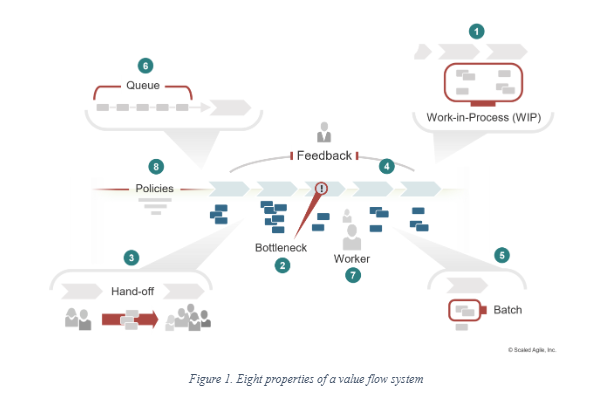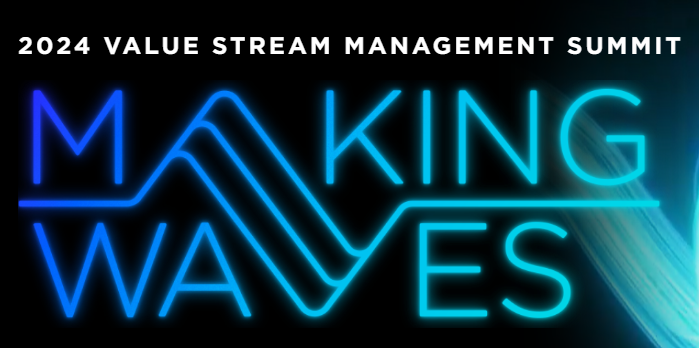This article was sponsored and contributed by Scaled Agile.
“When we start thinking about ways to line up all of the essential steps needed to get a job done into a steady, continuous flow, it changes everything.”
— James P. Womack and Daniel T. Jones, Lean Thinking
To remain competitive in the digital age, enterprises must respond to market changes quickly. This is the central theme of SAFe, to deliver a continuous flow of value to customers in the ‘shortest sustainable lead time.’ This article describes the strategies and techniques that organizations can apply to achieve this goal.
What is Flow?
Flow is characterized by a smooth transition of work through the entire value stream with a minimum of handoffs, delays, and rework. Value flow systems have eight common properties, as illustrated in Figure 1.

Each is described briefly below:
- Work in process. There is always some work moving through the system; if there weren’t, there would be no flow of value.
- Bottlenecks. In every flow system, one or more bottlenecks may limit value flow through the entire system.
- Handoffs. If one person could do all the work, handoffs would be unnecessary. But, in any material flow system, different individuals and teams have different skills and responsibilities. Each plays a role in advancing a work item through the system.
- Feedback. Customer and stakeholder feedback is necessary for efficiency and for effective outcomes. Ideally, feedback happens throughout the entire process.
- Batch. Since any system has a finite capacity, all the work can’t be done at once. Therefore, work occurs in batches, designed to be as efficient as possible.
- Queue. It all starts with a set of assignments. In addition, each value stream needs a mechanism prioritizing the sequence of work for optimal value.
- Worker. People do the critical work of moving work items from one state to another.
- Policies. Policies are essential to flow. Local policies determine how a work item moves from step to step. Global policies govern how work is performed throughout the company.
The eight flow accelerators
Each flow property is subject to optimizations. Making value flow without interruptions is best achieved by adopting the eight ‘flow accelerators.’
#1 Visualize and Limit WIP
Too much Work in Process (WIP) confuses priorities, causes frequent context switching, and increases overhead. The first corrective action is to make the current WIP visible to all stakeholders with a simple Kanban board. The next step is to balance the amount of WIP against the available development capacity.
#2 Address Bottlenecks
Wherever people or resources (systems, materials, and so on) experience greater demand than the capacity available, bottlenecks occur in the flow of value. To address them, additional skills, people, or other resources must be added at the bottleneck.
#3 Minimize Handoffs and Dependencies
Handoffs occur when work passes from one individual or team to another. Dependencies occur when teams can’t finish their work without help from other teams. Building cross-functional teams and ARTs — with all the necessary knowledge, resources, skills, and decision-making authority — creates an end-to-end flow of value that minimizes both.
#4 Get Faster Feedback
Applying the basic Plan-Do-Check-Adjust (PDCA) learning cycle enables fast feedback. Solution builders need two types of feedback from each PDCA cycle: feedback about building the right thing and feedback about building it right.
#5 Work in Smaller Batches
Smaller batches go through the system faster and with less variability, fostering faster learning. Reducing batch size typically involves investment in automating the Continuous Delivery Pipeline (CDP), including infrastructure and automation, continuous integration, builds, regression testing, and more.
#6 Reduce Queue Length
The longer the queue of committed work awaiting implementation, the longer the delay for new features, regardless of the team’s efficiency. Reducing queue length decreases wait time, reduces waste, increases flow, and improves predictability.
#7 Optimize Time ‘In the Zone’
People and teams ‘in the ‘zone’ demonstrate higher creativity, productivity, happiness, and fulfillment. There’s an essential connection between creating a work environment where individuals and teams can maximize their time in the zone and accelerating the continuous flow of value.
#8 Remediate Legacy Policies and Practices
During or after a Lean-Agile transformation, enterprises must remain vigilant for legacy policies and practices that inhibit flow. Examples include:
- Phase-gate milestones
- Unnecessary change control boards
- Obsolete tech standards
- Timesheet reporting
- Traditional performance reviews
They must be discovered, eliminated, modified, or mitigated.
These eight flow accelerators help teams increase throughput and deliver value faster. As an added benefit, implementing them gives people a sense of control over the process and triggers rapid and measurable improvements in customer satisfaction and employee engagement.




